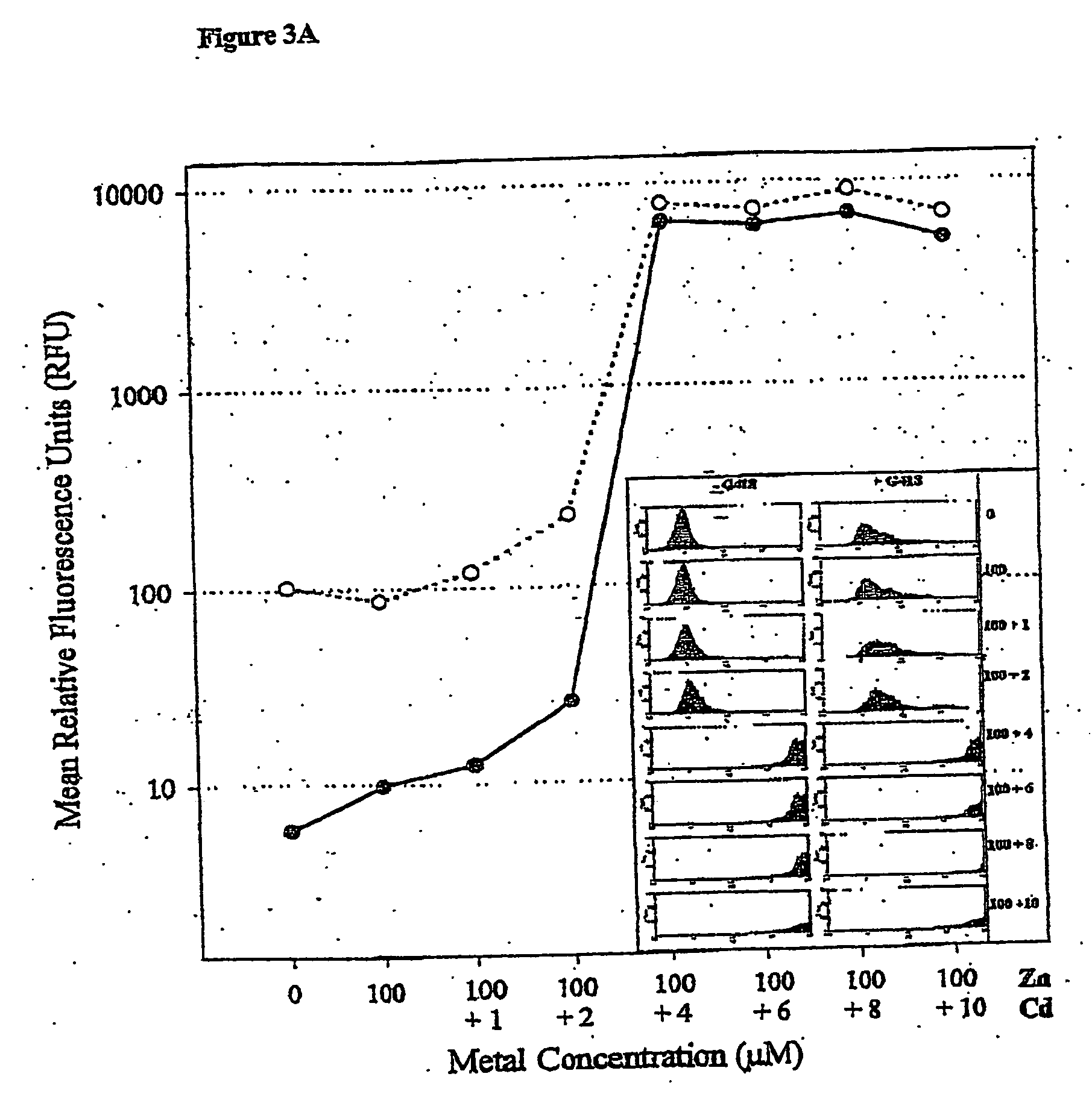Method of genetic screening using an amplifiable gene
a technology of amplifiable genes and gene expression, applied in the field of gene screening methods and related cells and genetic constructs, can solve the problems of limiting the amount of amplification that can be achieved, reducing the productivity of recombinant protein, and time-consuming and laborious search for random high producers, etc., to achieve the effect of reducing the production of products, high expression of amplifiable genes, and high levels of nucleic acids of interes
- Summary
- Abstract
- Description
- Claims
- Application Information
AI Technical Summary
Benefits of technology
Problems solved by technology
Method used
Image
Examples
example 1
Engineering the MTGFP Fusion Gene
[0070] The coding sequence for the enhanced Green Fluorescent Protein (eGFP, Clontech) was cloned in frame to the 3′ end of the human metallothionein IIA gene (MT)(15) using primer overlap extension PCR (16). For this purpose, four oligonucleotides were synthesized and are described as follows:
MTGFP-1:5′ TAC TCT TCC TCC CTG CAG TCT CTA 3′;MTGFP-2:5′ CAC CAT GGG CCC GGC GCA GCA GCT GCA 3′;MTGFP-3:5′ GCC GGG CCC ATG GTG AGC AAG GGC GAG 3′;MTGFP-4:5′ ATT TAC GCC TGC AGA TAC AT 3′
[0071] MTGFP-1 anneals −758 to −735 nt of the gene encoding MT relative to the translation start and includes the PstI site (5′ CTGCA / G 3′).
[0072] MTGFP-2 anneals to +630 to +656 relative to the MT transcription start site. The stop codon TGA is replaced by the sequence 5′ CCCGGG 3′ encoding two additional amino acids proline and glycine as well as the recognition sequence for the restriction enzyme ApaI
[0073] MTGFP-3 anneals to −9 to +18 relative to the transcription start...
example 2
Construction of Expression Vectors pMTGFP, pMTGFP / hGH and pMTGFP / CAT
[0076] The 2381 bp fragment containing the MTGFP coding sequence was digested with PstI to enable cloning into the expression vector pNK (12). After gel extraction the MTGFP containing fragment was cloned into pNKΔMT (MT gene deleted from pNK using PstI) to make pMTGFP. To construct pMTGFP / hGH, a 2223 bp EcoRI / KpnI fragment containing the genomic sequences of hGH (nt −559 to +2094 relative to the translational start site) was ligated to pMTGFP previously digested with the respective enzymes EcoRI and KpnI and transformed into DH5 bacteria. To construct pMTGFP / CAT, a 714 bp DNA fragment containing the coding region of CAT was obtained by digesting pNKCAT with HindIII and KpnI (12) and inserted into the respective sites in pMTGFP. DNA was isolated and purified from positive clones using anion exchange plasmid purification columns (Qiagen).
example 3
Cell Culture and Transfections
[0077] CHOK1 cells used to establish cell lines were derived from CHOK1 ATCC CCL61. All cells were grown in a complete medium (DMEM / Coons F12 mix (CSL) supplemented with 10% FCS (CSL). Cells were seeded into 35 mm plates 24 hours prior to transfection. For transactions, Lipofectamine 2000 (Life Technology) was used to transfect cells using optimum conditions for DNA and reagent mixes according to the manufacturer's protocol. Medium was removed 24 hours following transfection and replaced with fresh complete medium and plates were incubated for an additional 24 hours. The cells were then detached using EDTA / PBS and transferred to a T75 flask in fresh complete medium containing 400 μg / ml G418.
PUM
| Property | Measurement | Unit |
|---|---|---|
| temperature | aaaaa | aaaaa |
| temperature | aaaaa | aaaaa |
| concentration | aaaaa | aaaaa |
Abstract
Description
Claims
Application Information
 Login to View More
Login to View More - R&D
- Intellectual Property
- Life Sciences
- Materials
- Tech Scout
- Unparalleled Data Quality
- Higher Quality Content
- 60% Fewer Hallucinations
Browse by: Latest US Patents, China's latest patents, Technical Efficacy Thesaurus, Application Domain, Technology Topic, Popular Technical Reports.
© 2025 PatSnap. All rights reserved.Legal|Privacy policy|Modern Slavery Act Transparency Statement|Sitemap|About US| Contact US: help@patsnap.com



